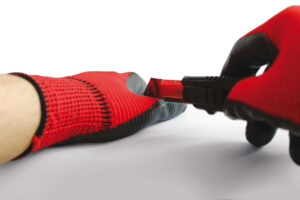ANSI/ISEA 105-2016 – American National Standard for Hand Protection Classification
“As a manufacturer that continues focusing its product development efforts on cut resistant gloves, the 2016 standard helped close the gaps between cut levels, particularly the A4 and A5 ranges. Furthermore, the added cut levels have allowed us to build products across all cut levels, while maintaining a focus on offering ground breaking technological advancements in hand and arm protection.” Armor Guys, (310) 504-1380, https://armorguys.com/
This standard addresses the classification and testing of hand protection for specific performance properties related to chemical and industrial applications. Hand protection includes gloves, mittens, partial gloves, or other items covering the hand or a portion of the hand that are intended to provide protection against or resistance to a specific hazard. This standard provides performance ranges for hand protection related to mechanical protection (cut-resistance, puncture resistance and abrasion resistance), chemical protection (permeation resistance, degradation) and other performance characteristics such as ignition resistance and vibration reductions based on standardized test methods. Descriptions of the test methods used in this standard are provided. Different levels of performance are specified for each property with zero (0) representing the minimal protection or none at all.
OSHA requires that employers select and require employees to use appropriate hand protection where there is workplace exposure to hazards such as chemical burns or severe cuts and lacerations. OSHA also mandates that such selection be based on an evaluation of performance characteristics of hand protection relative to the tasks being performed.
Major Provisions of the Standard
The 2016 revision of this standard addressed the classification and testing of hand protection for specific performance properties. Gloves are classified to a performance level ranging from 0 to 6 based upon their performance when evaluated against defined industry test methods for:
- Mechanical protection (cut-resistance, puncture resistance and abrasion resistance)
- Chemical protection (permeation resistance, degradation)
- Other performance characteristics such as ignition resistance and vibration reductions
It included an expanded nine-level classification system for cut-resistance, including the use of a single test method for testing in an effort to provide consistent meaning of the ratings from the end-user perspective (and to embrace the approach used in international standards). ANSI also increased the range of cut resistant protection levels.
Testing Protocols
- Cut resistance to glass, knives, sheet metal, bladed tools and other sharp objects is tested using the ASTM F2992-15 test method and TDM (Tomodynamometer) cut test machine. A straight-edge blade is run over the material used in protective clothing until it cuts through. Multiple iterations are performed, using new blades and different loads. The resulting resistance ratings range from A1 (very minor cuts) to A9 (highest cut danger).
- Abrasion resistance is tested using Taber Abrasion equipment following the ASTM D3389-10 and D3884-09 test methods.
- Puncture resistance tests material with a hypodermic needle under pressure, following the ASTM F2878 test method.
- Chemical protection testing is in accordance with the ASTM F 739 method, in which a piece of the exterior side of glove material is exposed for a period of time to a certain chemical, and the interior side is examined at intervals to determine if the material has been permeated.
- Flame resistance testing is performed per the methodology provided in ASTM F1358-16.
- Heat resistance is tested in accordance with ISO 17493:2016.
- Conductive heat resistance of cut resistant gloves are tested per ASTM 1060-08.
- Vibration reduction testing is done according to ANSI S2.73-2002 / ISO 10819:2013 and results in only pass or fail classifications.
Why a Standard
Work-related finger and hand injuries range from minor to life changing. They can cause discomfort and a temporary inconvenience to both employee and employer, by necessitating a work stoppage so that first aid can be rendered. They can also result in permanent disability and enormous costs in terms of medical care, loss of income, workers compensation and reduced productivity.
Common types of workplace hand injuries include lacerations and cuts, punctures, burns, fractures, amputations, sprains and skin irritations. There is a considerable range of severity within each of these categories. A laceration can leave a small cut, or it can sever a nerve and leave permanent damage. Burns occur when hands are exposed to steam or hot liquid, caustic chemicals or electricity. Pointed tools or machinery can puncture hands. Contact with heavy machinery can cause fractures and crush hands — the latter sometimes requiring amputation. Hazardous substances are usually the culprit in skin irritation. Repetitive movements and slips and falls can also lead to sprains.
About the Standard
The tremendous number of hazard-specific work gloves available today can make selection challenging. Technological developments have produced high-performance materials and composite yarns that — together with improved manufacturing processes — create ultra-tough, highly specialized hand protection. ANSI/ISEA 105-2016 is a voluntary global standard that manufacturers can use as a basis for testing and classifying their products. Those classifications, in turn, enable managers to sort through the options and choose the gloves best suited to the applications, environments and hazards to which their workforce will be exposed.
Get the standard at: https://isea.safetyequipment.org/atlas/ecommerce/item/7 WMHS




